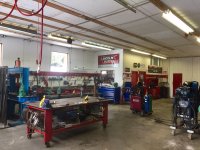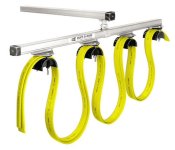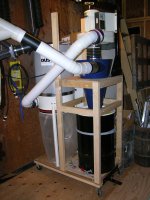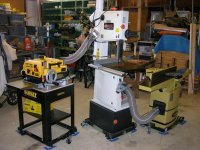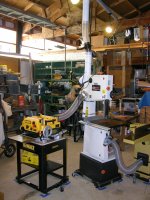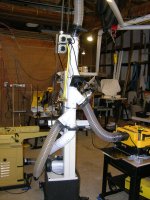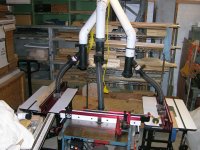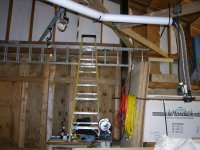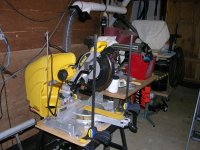BukitCase
Elite Member
- Joined
- Feb 17, 2012
- Messages
- 2,756
- Location
- Albany OR
- Tractor
- Case 580B, Long 460, Allis-Chalmers 160
I use these for pins
5/8 in. Easy Grip Hitch Pin
Personally I wouldn't use anything lighter. I have receivers all over, hitch pin holes always within 2" of the OUTER end - I doubt you'll enjoy reaching that far under your table to pin/un-pin (especially as you get older) - Main reason for the heavier pins - you never know when you're gonna want to BASH on something that's in the receiver - one example: a simple hitch ball in a receiver can double as a quickie "dimpler" sometimes - a piece of railroad rail welded onto a piece of heavy wall 2" tube can be a makeshift anvil, etc...
For "un-sloppers" I stay with 5/8 nuts - be aware that this method can allow metal shavings into the threads on the INSIDE of the welded nut, and too many in/outs can take out the threads -
two ways I get around this -
One, before I insert a different "tool" in the ones with welded nuts, I use the air hose and blow out that area, or
Two, I'll sometimes make my own "dog point set screw" out of a grade 5 short bolt -
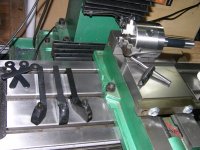
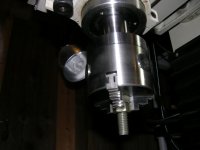
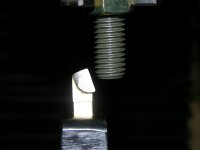


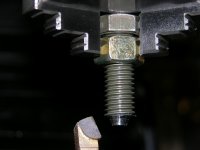
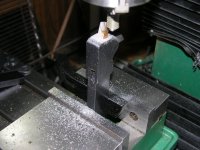
I'd have done that on my lathe, but it doesn't exist (yet) - so I found that little 3" chuck with an R8 shank, works for small/simple stuff - the other tooling shown is just a basic set of brazed carbide lathe tools and a vise...
If you're not familiar with "dog-point" screws, they're normally used for set screws and usually only available in allen head - purpose is to NOT have threads at the end, so they don't get "smushed" and ruin the female threads when backed out...
If you mount your electrical box where you show it, it'll probably interfere with pin insertion/removal - I'd consider moving it down (up in your pic) the leg 2-3", and you may later wanna add another box for more/different plugs - if that happens, search for "chase nipple", they're available in all knockout sizes. With one of those, 2 conduit nuts and 2 plastic "caps", you can safely run wiring thru to the second box - TWO of those at the outside corners of a box is sturdy enough NOT to need the second box attached to the table leg... I wouldn't weld the box, a couple of #10 metal screws should do.
Lookin' real good so far, you're gonna really enjoy that table... Steve
5/8 in. Easy Grip Hitch Pin
Personally I wouldn't use anything lighter. I have receivers all over, hitch pin holes always within 2" of the OUTER end - I doubt you'll enjoy reaching that far under your table to pin/un-pin (especially as you get older) - Main reason for the heavier pins - you never know when you're gonna want to BASH on something that's in the receiver - one example: a simple hitch ball in a receiver can double as a quickie "dimpler" sometimes - a piece of railroad rail welded onto a piece of heavy wall 2" tube can be a makeshift anvil, etc...
For "un-sloppers" I stay with 5/8 nuts - be aware that this method can allow metal shavings into the threads on the INSIDE of the welded nut, and too many in/outs can take out the threads -
two ways I get around this -
One, before I insert a different "tool" in the ones with welded nuts, I use the air hose and blow out that area, or
Two, I'll sometimes make my own "dog point set screw" out of a grade 5 short bolt -







I'd have done that on my lathe, but it doesn't exist (yet) - so I found that little 3" chuck with an R8 shank, works for small/simple stuff - the other tooling shown is just a basic set of brazed carbide lathe tools and a vise...
If you're not familiar with "dog-point" screws, they're normally used for set screws and usually only available in allen head - purpose is to NOT have threads at the end, so they don't get "smushed" and ruin the female threads when backed out...
If you mount your electrical box where you show it, it'll probably interfere with pin insertion/removal - I'd consider moving it down (up in your pic) the leg 2-3", and you may later wanna add another box for more/different plugs - if that happens, search for "chase nipple", they're available in all knockout sizes. With one of those, 2 conduit nuts and 2 plastic "caps", you can safely run wiring thru to the second box - TWO of those at the outside corners of a box is sturdy enough NOT to need the second box attached to the table leg... I wouldn't weld the box, a couple of #10 metal screws should do.
Lookin' real good so far, you're gonna really enjoy that table... Steve
